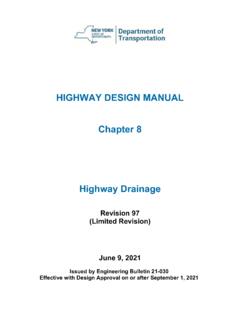Transcription of City of New York, NY Flood Hazard Mapping Status Report ...
1 City of new york , new york Flood Hazard Mapping Status Report for property Owners This fact sheet provides background information on the National Flood Insurance Program (NFIP). administered by the Federal Emergency Management Agency (FEMA) as well as an overview of the Flood Hazard Mapping process being completed for City of new york , new york . The Flood Insurance Rate Maps (FIRMs) for City of new york are being revised to reflect new data so residents, homeowners, business owners, and community officials can better understand their Flood risk and manage development.
2 BACKGROUND. What Is The NFIP? In 1968, Congress established the NFIP in response to escalating costs to taxpayers for Flood disaster relief. The NFIP is based on the agreement that if a community practices sound floodplain management, the Federal Government will make Flood insurance available. FEMA maps Flood Hazard areas, including the Special Flood Hazard Area (SFHA), which is the area that has a 1% or greater chance of flooding in any given year. Development may take place within the SFHA provided that it complies with local floodplain management ordinances that meet the minimum Federal criteria.
3 What Is A FIRM? When FEMA maps Flood hazards in a community and/or county, two products are typically produced: a Flood Insurance Study (FIS) Report and a Flood Insurance Rate Map (FIRM). A FIRM illustrates the extent of Flood hazards in a community by depicting Flood risk zones and the SFHA, and is used with the FIS Report to determine who must buy Flood insurance and the floodplain development regulations that apply in each Flood risk zone. FIRMs also depict other information including Base Flood Elevations (BFEs) and/or depths associated with the risk zones and floodways, and common physical features such as roads.
4 What Is The Significance Of The SFHA? The SFHA has at least a 1% chance of flooding in any given year, and at least a 26% chance of flooding over the life of a typical 30-year mortgage. The Flood Disaster Protection Act of 1973 mandates that Flood insurance must be purchased for structures located within the SFHA as a condition of receipt of Federal or federally backed financing. CITY OF new york 'S FIS AND FIRM REVISION. The December 5, 2013 preliminary FIRM: Incorporates revised Flood Hazard analysis and Mapping for the coastal shoreline of NYC.
5 Redelineation and Mapping for 31 miles of detailed riverine analysis and approximate/regression based analysis streams Updates the base map to 2008 aerial photography Incorporates 2010 digital topographic data provided by NYC. Incorporates validated Letters of Map Change (LOMCs). December 5, 2013. City of new york , new york Flood Hazard Mapping Status Report for property Owners Flood INSURANCE RATE MAP. The December 5, 2013, preliminary FIRM for City of new york , incorporates a base map (2008 High Resolution Orthophotography), supplemented with stream centerlines, and political and road name data.
6 The key components of a FIRM. are shown in the figure below. + + =. Base Map Topography Flood Data Digital FIRM. RESTUDIES AND REDELINEATION. Revised Flood Hazard analysis and Mapping were incorporated for the coastal shoreline of the City of new york . Redelineation was also performed for approximately 31 stream miles in the Boroughs of Bronx and Staten Island. Redelineation uses digital elevation data and effective Flood elevations to revise the 1% and annual chance Flood Hazard areas without conducting new hydrologic or hydraulic analyses.
7 For more information for this revision, please see the accompanying insert City of new york Floodplain Mapping Fact Sheet.. VERTICAL DATUM CHANGE. What Is A Vertical Datum? A vertical datum is a set of constants that defines a system for comparison of elevations. In the NFIP, a vertical datum is important because all elevations need to be referenced to the same system. Otherwise, surveys using different datums would have different elevations for the same point. Historically, the FIRMs have referenced the National Geodetic Vertical Datum of 1929.
8 (NGVD 29). Now, a more accurate vertical datum is used the North American Vertical Datum of 1988 (NAVD 88). Why Is The Vertical Datum Changing? Sample Datum Conversion A datum needs to be updated periodically because geologic changes to the surface of the earth occur due to subsidence and uplift or changes in sea level. In addition, NGVD 29 was flawed because of erroneous assumptions that mean sea level at different tidal stations represented the same elevation (zero). We can now more accurately measure these elevation differences with an expanded geodetic network.
9 Who Will Be Impacted By The Vertical Datum Change? Elevations in NAVD 88 should be used for floodplain management and Flood insurance purposes. This change should be noted by anyone who uses the FIRM, particularly when comparing elevation data on the new FIRM with data from an old FIRM that was produced in NGVD 29. How Are NGVD 29 Flood Elevations Converted To NAVD 88? The difference between the two datums varies from location to location. An average offset (the difference between NAVD 88. and NGVD 29) has been computed for City of new york .
10 To convert from NGVD 29 to NAVD 88 in the City of new york , use the following equation: NAVD 88 = NGVD 29 feet. For more information on the vertical datum change, see FEMA's publication Converting the National Flood Insurance Program to the North American Vertical Datum of 1988 . Guidelines for Community Officials, Engineers, and Surveyors. Note that in new york City, each borough has its own historical vertical datum. Calculations to perform conversions from these borough-specific datums to NAVD88 are located at City of new york , new york Flood Hazard Mapping Status Report for property Owners Flood Hazard Mapping PROCESS.










